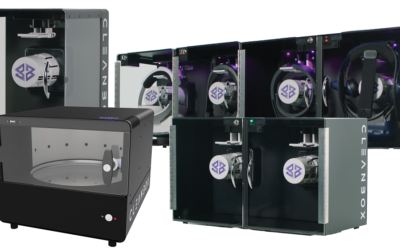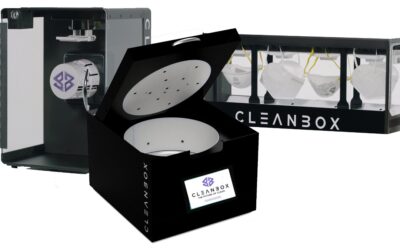Maintaining a sanitary classroom environment was a struggle even before the Coronavirus pandemic. Whenever individuals, particularly children, are crowded together in an indoor space, the risk of virus spread is a serious concern. It’s time to implement consistent hygiene protocols in the classroom. Cleanboxe’s UVC cleaning systems, specifically the OmniClean, offer a solution.
K12 Schools Need a Modern, Standardized Approach to Decontamination
Although most schools have evolved their curriculum and programs, little progress has been made in classroom hygiene. This stagnation leaves educators and students at risk from any pathogen that makes its way into the classroom. The Coronavirus pandemic highlighted how rapidly contagious illness can spread from one individual to another and how crucial it is to have standard operating procedures already in place for practicing hygiene in the classroom.
Any practice implemented will need to be user-friendly, economical, and effective. It will also need to be able to tackle the factors that make maintaining a hygienic classroom challenging, such as gathering individuals from different locations, proximity to one another, and shared objects. UVC cleaning systems such as the OmniClean check all the boxes necessary to be a disinfection solution and offer a practical way of preventing disease transmission.
How Cleanbox Works
These systems work by harnessing ultraviolet C rays and using them to eliminate pathogens. Ultraviolet C rays are a wavelength of light that is only naturally found outside the Earth’s atmosphere.
Because it does not occur organically on Earth, viruses, bacteria, and fungi have not created an immunity to it, which causes the rays to be a powerful method of decontamination. UVC rays work on viruses and bacteria by destroying the DNA and RNA inside the pathogens. Since RNA and DNA are necessary for contagions to reproduce, the pathogens are neutralized once these components have been disrupted.
Targeted Disinfection
For ultraviolet C rays to be effective, they must meet specific parameters, including distance, duration, intensity, line of sight, reflectivity, shadowing, and surface coverage. While many companies advertise devices with UVC bulbs and claim they can eliminate germs, that is untrue. Unless UVC light meets specific levels in all the above categories, it has little value as a decontamination aid.
Cleanbox systems use a proprietary type of LED UVC engineering that eliminates 99.999% of contagions. All products are independently lab tested, providing users with the peace of mind that their decontamination is thorough. No crack or crevice of a device goes uncleaned, and decontamination only takes 60 seconds.
Contemporary Classroom Issues
Although schools are providing students with greater learning opportunities through technology, the possibility of contagions on shared equipment is one more worry for already overworked teachers to manage. Devices such as virtual and augmented reality systems, calculators, interactive handheld games, and tablets are all items that benefit students while also increasing the potential for illness to spread through a class.
Parents of school-aged children know how quickly illness can travel from one child to another; when shared technology is added to the picture, that speed only increases. In the younger grades especially, tech gadgets can become a type of typhoid Mary, spreading disease unchecked throughout the classroom community.
UVC Cleaning Systems Offer a Modern Solution
Increased types of shared technology are being utilized in school districts, but educators are not receiving resources that enable them to keep devices clean. Without a standardized process in place, educators will have to fall back on whatever supplies they have, using whatever free time they have. An unfortunate reality in most school districts is that neither time nor resources are readily available.
Wave Goodbye to Wipes
Unless an educator is provided with an alternative solution, they will be forced to fall back on obsolete cleaning methods. Wipes are one of the most common disinfection methods used in the classroom. While the educators using wipes mean well, wipes fall short of being an adequate solution for contaminated equipment for the following reasons:
Time Consuming
In order for wipes to be moderately effective, the person performing the cleaning must pay close attention to detail. That means making sure no seam, screw, or shadow goes uncleaned, and the surface of the device is allowed to remain damp for the amount of time suggested by the manufacturer.
Unfortunately, during a busy school day, there’s no time for educators or students to clean shared electronics thoroughly. This time-constraint means equipment will either get a mediocre wipe that leaves behind pathogens or no cleaning at all.
Wasteful
In addition to wasting time, wipes also waste money. Supplying enough wipes to clean the equipment for even one class for the school year is expensive; multiply that by the whole school, and the amount of money spent on wipes becomes outrageous.
Adding to the frustration is the fact that most educators are already working on a limited budget, and many reach into their own pockets to supply their classrooms with necessities. The money spent on wipes could be used more productively than for buying wipes that are thrown away after one use.
Failure to Remove All Pathogens
There’s no way to verify if the cleaning was successful, which places students and educators at the mercy of whoever cleaned the device before them. In addition, many variables make it impossible to guarantee device safety. For example, the level of cleanliness is affected by the user’s actions, the amount of disinfectant present on the wipe, how effectively it covered the surface, and if the disinfectant was allowed to dry the appropriate amount of time before use.
Chemical Threats
Using harsh chemicals in a school setting presents significant risks since there are children present who may have allergies to the chemicals being used to clean shared educational items. This risk is exceptionally high in classrooms with younger students.
Many children have unknown allergies or medical conditions, such as asthma or croup, that cause them to be vulnerable to chemical cleaning agents. Even individuals without allergies can experience skin irritation and burning if they use equipment that isn’t allowed to dry the appropriate amount of time.
The OmniClean: Waste-Free and Efficient
The OmniClean addresses every issue presented by wipes. Designed to eliminate 99.999% of pathogens on any item that can fit within the device, the OmniClean is incomparable to anything else on the market. When an item is placed inside the chamber, it is disinfected by 360 degrees of UVC light rays. Over 30 globally-patented LEDs combined with reflective surfaces and a rotating quartz plate ensure no surface or shadow misses decontamination.
User-Friendly Rapid Disinfection
With a 60-second cleaning cycle, even the busiest educator can maintain hygiene standards in their classroom. In addition, educators can take a hands-off role in disinfection in classrooms with older students, as this device is highly user-friendly. Students only have to place an item inside, start the cleaning cycle, and wait for 60 seconds, and they will have a disinfected item ready to be used.
Finally, this device is also budget-friendly since there are no expenses beyond the purchase price. The average Cleanbox UVC cleaning system lasts for years and pays for itself quickly compared to expensive options such as disposable wipes.
As technology use increases in classrooms, schools will need to establish a disinfection protocol that ensures the safety of educators and students. Outdated cleaning practices such as wipes should be discarded for contemporary solutions like UVC technology. Contact Cleanbox today and discover how UVC cleaning systems can improve classroom hygiene practices.





